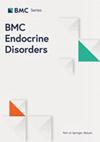中国普通人群中 25 羟基维生素 D 与血清尿酸水平的关系:一项横断面研究
IF 2.8
3区 医学
Q3 ENDOCRINOLOGY & METABOLISM
引用次数: 0
摘要
现有文献对血清尿酸(SUA)与 25-羟基维生素 D(25(OH)D)之间的关系描述不一,在中国人群中有关其性质和影响的结果也不一致。本研究旨在澄清这种关联,同时考虑维生素 D 水平对 SUA 的潜在影响。这项横断面研究涉及浙江大学医学院附属第二医院在 2020 年全年筛查的 7086 人。我们收集了 25(OH)D、SUA 和其他代谢指标的数据。我们利用调整了混杂因素的逻辑回归模型来分析这些关系。我们的研究结果表明,25(OH)D 与 SUA 之间存在具有统计学意义的倒 U 型关系。28.82 纳克/毫升的阈值效应是关键;25(OH)D 水平低于此值会增加高尿酸血症的风险(几率比:1.0146,P = 0.0148),高于此值则具有保护作用(几率比:0.9616,P = 0.0164)。我们的研究结果证实,25(OH)D 和 SUA 之间存在非线性的倒 U 型相关性,强调了将维生素 D 水平维持在特定范围内对有效控制高尿酸血症的重要性。这些结果支持实施个性化的维生素 D 补充策略,以优化代谢健康结果,同时强调了维生素 D 状态与尿酸水平之间复杂的相互作用。本文章由计算机程序翻译,如有差异,请以英文原文为准。
Association between 25 hydroxyvitamin D and serum uric acid level in the Chinese general population: a cross-sectional study
The relationship between serum uric acid (SUA) and 25-hydroxyvitamin D (25(OH)D) has been variably characterized in existing literature, with inconsistent results regarding its nature and implications in the Chinese population. This study aims to clarify this association, considering the potential impact of vitamin D levels on SUA. This cross-sectional study involved 7,086 individuals from the Second Affiliated Hospital of Zhejiang University School of Medicine, screened throughout 2020. We collected data on 25(OH)D, SUA, and other metabolic markers. Logistic regression models adjusted for confounding factors were utilized to analyze the relationships. Our findings illustrate a statistically significant inverted U-shaped relationship between 25(OH)D and SUA. The identified threshold effect at 28.82 ng/ml is pivotal; with 25(OH)D levels below this point associated with an increased risk of hyperuricemia (odds ratio: 1.0146, p = 0.0148), and levels above it offering protective benefits (odds ratio: 0.9616, p = 0.0164). Our findings confirm a nonlinear, inverted U-shaped correlation between 25(OH)D and SUA, emphasizing the importance of maintaining vitamin D levels within a specific range to effectively manage hyperuricemia. These results support the implementation of personalized vitamin D supplementation strategies to optimize metabolic health outcomes, highlighting the complex interplay between vitamin D status and uric acid levels.
求助全文
通过发布文献求助,成功后即可免费获取论文全文。
去求助
来源期刊

BMC Endocrine Disorders
ENDOCRINOLOGY & METABOLISM-
CiteScore
4.40
自引率
0.00%
发文量
280
审稿时长
>12 weeks
期刊介绍:
BMC Endocrine Disorders is an open access, peer-reviewed journal that considers articles on all aspects of the prevention, diagnosis and management of endocrine disorders, as well as related molecular genetics, pathophysiology, and epidemiology.
 求助内容:
求助内容: 应助结果提醒方式:
应助结果提醒方式:


